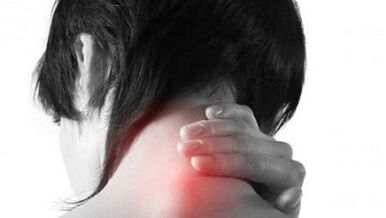
How can you heal osteochondrosis of the cervical spine and what is the reason for your appearance?This problem worries women and men who are forced to solve the problems with health problems every day: from annoying symptoms in the neck to severe headaches and other problems.
The main reason for the development of the disease is to reduce the distance between the vertebrae due to the destruction of the cartilage between them.
As a reference.Osteochondrosis in the cervical spine is a degenerative dystropic-progressive disease that is widespread due to the excessive mobility of the vertebrae in the neck.Osteochondrosis of the spine causes uncontrolled physical activity, injuries and weak muscle corset.All of these causes ultimately lead to the development of cervical osteochondrosis.
Etiology of the disease
The main reason why cervical osteochondrosis develops is to reduce the distance between the vertebrae due to the gradual destruction of the cartilage between them.Every uninjured position provokes the vertebral shift and the vessels and nerves are caught.
The most characteristic causes of the development of osteochondrosis:
- Genetic predisposition to the disease.
- Obesity and metabolic disorder.
- Frequent infections, poisoning of the body.
- Bad, inferior diet with the minimal absorption of vitamins, trace elements and liquids, which leads to the deformation of the vertebrae.
- The curvature of the spine, injuries, bruises, fractures, violation of the attitude (osteochondrosis of the initial department).
- Flat feet and instability in the spine segments, also in the bodies of the cervical vertebrae.
- Work in connection with the lifting of weights or frequent changes in the position of the body (jerking, turning).
- A sitting lifestyle, bad ecology.
- Do hard work with an undeveloped bone muscle system that leads to deformation of the vertebrae.
- A long -term forced position of the body, nervous overvoltage and stress.
- "False" sleeping pillows that change the position of the vertebrae of the cervix region.

A sitting lifestyle increases the risk of the disease.
It is important to remember that the beginning of osteochondrosis cannot be noticed.Therefore, with unpleasant sensations in the neck, it is necessary to contact a specialist in good time.
The following causes of osteochondrosis are theoretical, but found in practice:
Involutionary
During the age of the body, they are associated with disturbed tissue trophic, which mainly applies to the intervertebral discs and vertebrae, where a large number of blood vessels pass.
Hormonal
Together with hormonal diseases, dystrophic changes (osteochondrosis) occur in the body, in which the intervertebral discs are involved in the process.
vessel
They are observed in the event of a violation of the segmental circulation and water salt metabolism.Then dystrophic changes are formed in tissues and organs, including the neck osteochondrosis.
Infectious
The infection, which occurred in the intervertebral discs of the cervical spine and the surrounding tissue, disturbs the diffusion of the lymphatic fluid and leads to a change in the tissue and cervical vertebrae in the diet.This causes degenerative changes in the spine that are inherent in osteochondrosis.
Bioelectricity
The inversion of the vector forces of bioelectric fields in the intervertebral disc occurs due to injuries, overload and temperature changes.Ultimately, osteochondrosis of the spine and most frequently polysgent appears.
Mechanically
Injuries and considerable overload of the spine lead to a violation of the integrity of the fibrous ring and the dystrophy of the cervical spine.
Anomalin
This refers to congenital anomalies of the spine and their individual structures.At the same time, the healthy vertebrae of the cervix region take on a double load, which leads to their quick wear and development of the neck osteochondrosis.
Functional
Primary pathological changes relate to muscle tissue due to congenital or acquired factors.An uneven contraction of the muscles in a level provokes the neck osteochondrosis.
Disease stages
The cervical osteochondrosis has four degrees of illness.They are characterized by special symptoms and changes that affect the cervix region:

- In the 1st degreeDamage to the pulposcerne occurs as a result of a violation of metabolic processes.It becomes less elastic, excludes and is not finished with the loads in the cervical spine.In the 1st degree, the patient does not feel any pain, only stiffness occasionally occurs.Treatment in this phase of the damage in the cervix region is most effective, a simple massage gear helps.
- 2 degreesDamage to the fibrous ring occurs, microrises form on the side and rear surfaces of the vertebral disc.The patient with pathology in this degree begins to feel pain on the neck.
- 3 degreesThe bone structure is subject to changes, the fibrous ring is deformed and torn.All nearby tissues, nerves and blood vessels suffer, a lack of air, noise in the ears and the head are felt by the patient.Osteochondrosis of the neck in 3 degrees is characterized by the occurrence of painful pain in the back of the head and turning the head is very difficult.
- In 4 degreesThere is a degenerative restoration of the spine, the process takes about a year.In the event of a deformed vertebra, a change in bone tissue growth occurs (in width grows).The sick spine gradually turns into a static painless frozen bone column.
Only the timely prevention of osteochondrosis will help prevent the development of the disease.
The primary manifestations of osteochondrosis, including polysgmentary, are found after 35 years.The older the person, the more often the patients complain about a specialist about the pain in the neck.The most common causes of pathology are a long stay on the computer in our time and drive a car.Such forced positions of the spine lead to destabilization in the spine.
Characteristic clinical manifestations
The symptoms of cervical osteochondrosis have a pronounced personality and differ from the symptoms of the manifestation of the disease in a different spine.This is due to the characteristics of the structure of the vertebrae and the fact that they are much closer than in the thoracic and lumbar sections.Therefore, even with the slightest pathologies, cervical osteochondrosis turns faster.
The following signs of an osteochondrosis of the cervical spine are the most characteristic:
pain
The very first symptom that is informed of a person about the start of the problem in the neck.It can be localized: neck, back, shoulder, top of the hand.If a spine of the nerve is involved in the pathological process, which is "responsible" for the innovation of the upper part of the hand, there are unpleasant sensations that resemble weight description.Pain in the back of the head occurs with severe cramps of the muscles of the neck, which are attached to the occipital bones.In addition, blood flow is disturbed, which causes the occurrence of symptoms of poor blood supply in the brain.
Weakness in the hands

Such a symptom is caused by damage to the nerve root and fibers that perform the motor function and inner the muscles of the hands.
The symptom of the disease can be weakness and poor sensitivity in the hands.
Bad sensitivity in the hands
This symptom is explained by damage to sensitive nerve fibers that inner four.
Crown and restriction of neck mobility
These are characteristic symptoms that show the "drying" of the intervertebral disc.In addition, the growth of the bone tissue and the degeneration occurs in small joints between the cervical vertebrae.
Bad coordination
The symptoms indicate that cervical osteochondrosis progresses.The nerves and the vertebral artery are pressed, and if the fiber tissue is formed and the vertebral drags deteriorate, blood flow deteriorates, which leads to the occurrence of symptoms, which indicates poor blood supply to the cerebellum and brain.In severe cases, the following symptoms develop: hearing loss, deafness of language, visual problems.
As you can see, osteochondrosis is by no means a harmless illness that symptoms are eloquently eloquent.
The principles of therapeutic measures
The treatment of cervical osteochondrosis in men and women is based on stopping all symptoms of the disease and eliminating the causes of why cervical osteochondrosis developed.The symptoms are mainly associated with the compression of the nerve fibers and blood vessels.It is therefore primarily to restore edema, inflammation and normal blood supply.A cervical osteochondrosis in the early stages withdrew successfully when physiotherapy exercises are involved if the medication does not use the help.
The success of the treatment only depends on the teamwork of qualified doctors.
With the development of cervical osteochondrosis, the local therapist, which is almost always addressed primarily, helps little.As a rule, his treatment is only symptomatic, but it is unable to completely find and eliminate the cause of the disease.Therefore, the success of the treatment only depends on teamwork qualified doctors: vertebroneurologist, neurologist, surgeon, physiotherapist and masseur.

Treatment of osteochondrosis of the cervix region is important to start at the very early stage, otherwise a strong change in the vertebrae occurs in the 2-3 stadiums and the treatment will be long, difficult and not always effective.The basis for the treatment of problems in the neck is to take medication, physiotherapy, massage and therapeutic exercises.
Preparations for cervical osteochondrosis:
- NSAID.
- Vitamin preparations.
- Medicines that improve blood flow.
- Musorelaxants.
- Chondroprotectors.
The treatment of cervical osteochondrosis is carried out using the following physiotherapeutic methods:
- Ultrasound (relieves pain, improves metabolic processes).
- Electrophoresis (delivery of medication into a problem area).
- Laser therapy (inflammation and improves blood circulation).
- Magnetotherapy (relieves tissue edema).
The cervical osteochondrosis should not be underestimated.Very often in men and women there is a slight discomfort in the neck, especially at a long session on the computer or in another forced position.At the beginning, you do not have to take medicines, but try to remove the cause or to regularly remove a slight charging (at work or at home).Indications for surgical treatment: a lack of conservative treatment (medicine, physiotherapy, gymnastics), constant pain, myelopathy, disturbance of the brain cycle.
























